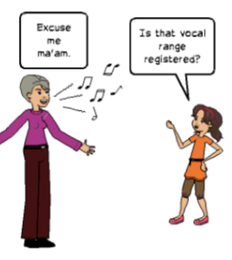 I have spent the majority of my professional music career in church music. When I began as a young teenager, I found that I had a hard time singing above certain pitches. My teenage self regarded these “certain pitches” as my “normal” voice. Everything above that area was deemed different and separate. I could also phonate below my “normal voice”, but that was quite low and only used to be funny or to imitate my father. Thus I stumbled into the marvelous and confusing world of registers. Now many people have written at length, on what is and is not a register. I do not wish to participate in the larger scientific and pedagogic discussion overall on defining registers. This blog is merely to reassure the beginning singer and speaker of what may be happening to their voice, or maybe to inform the non-novice of perhaps a better and clearer way to speak of a real physiological process. However, I still have to propose what I believe is the correct definition of a register. A register is a group of tones that a speaker and/or singer produces which share the following: similar sound qualities, as well as similar methods of producing the tones. An example is if I asked you to pretend you were the character of “Lurch” in the Addams Family. You would produce tones that might be classified by some as Vocal Fry by the sound. At the same time, if we were to see your vocal folds, as well as measure the air coming through them as you produced the sound, we would see them behaving in a manner that is fairly relaxed, but with a lowered quantity of air (Johns Hopkins). This method of phonating (vocalizing) has been likened to perhaps strumming a very loose guitar string. (Brainstuff).
 ,, What my teenage self imagined as my “normal voice” was the pattern which is often described as “modal voice”. This is nicely visualized in this graphic from Wikipedia. It is the type of phonation where the muscles of the vocal fold vibrate while opening and closing. It is a cycle which begins in the lower portion of the fold and then followed by the upper portion. It is the default speaking mode of most people and thus regarded by many as the “normal voice.” Now remember there have to be two components to speaking of register—the tone as well, as the method of the voice production. If you are just speaking of a tone…and not a change in the movement pattern of the vocal folds, I suggest you use the term resonance. We will get to resonance another time. When I began voice lessons, I thought I had a flawed voice because, it suddenly got “strange” to this Ann Wilson, Robert Plant, wanna-bee. With guidance I learned fairly quickly to start working out those areas and quickly discovered my upper range, which was comprised of a falsetto register (or a head register) and eventually a whistle register. Unbeknownst to me I was training my muscles to make smooth adjustments while transitioning between my modal range and the falsetto range. Just like two dancers, two pairs of muscles had to balance each other out as the pitch went up or down.
Shifting registers is a motor learning process, not that much different from learning how to dance, to play the piano, to skip, or, to eat using chopsticks. The more often I worked on shifting my registers, the more comfortable I became with those transitions, until, well until it was like walking. So to the novice singer who is frightened or uncomfortable with those transitions, I say, “fear not.” Remember you didn’t learn how to read instantaneously, or eat neatly without practicing everyday. Working your registers correctly will need the same practice! Don't be afraid to ask for help from an instructor when you need it!
1. http://www.ncvs.org/pas/2004/pres/thurman/ThurmanPaper.html
0 Comments
Your comment will be posted after it is approved.
Leave a Reply. |
Trissa DiBenedetto WAlterIs a singer, voice teacher, speech language pathologist, and certified vocologist Archives
July 2020
Categories |
 RSS Feed
RSS Feed